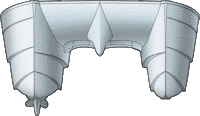FAQ’s with Larry Graf
Aspen’s original design in 2008 called for a soft riding, dry, stable, all-weather hull shape that maximized efficiency. In studying ways to reduce drag it became very apparent that hull beam had a very positive or negative effect. After extensive research and modeling it was determined that a cat hull with one hull 35% thinner than the other produced a dramatic decrease in drag and subsequently horsepower requirements. The final design, tailored to single or twin engines typically requires half the horsepower of similar size boats. It also equates to half the engine weight, half the fuel cargo and twice the efficiency. All significant benefits.
There are many factors that drive pricing:
- First, our hull shape includes 65% more surface area than a similar sized mono hull. The deck includes 40% more surface. While this does give the cat more usable room, it takes special materials and additional labor to build the larger parts.
- Second, my nature, based on my boating experience, is to find and use the most reliable, highest quality parts. Throughout the boat, from gel coat to bilge pumps, and electrical components, we seek out the best. Our view is Aspen owners are seeking fun on the water, not a repair project. They also see that this quality plays a large part in future resale value and the ultimate cost of ownership. Higher resale value in relation to purchase price equals the ultimate cost.
- The final area that affects price is that all of our boats are built in the USA. Aspen production process meets or exceeds all EPA and environmental requirements. We pay significantly benefits and very competitive wages to our premier Craftsman. We also receive no government subsidies like many foreign competitors do for engineering and tooling. Some off shore competitors even get paid to train their boat builders on new models for 1-2 years.
Every Aspen is built to order. Our typical lead times run 8-14 months depending on the model and sales demand. Lead time can change quickly depending on a particular show and owner demand. Our longest lead times extended 2 ½ years in 2022 with the introduction of the C108. New models often extend lead times as we hire and train new team members.
Yes, to some degree, our purchase contracts address both these concerns. But marine component inflation the last 18 months has run a little under 3%, so manageable. For Tariffs we’re in new territory. Over 90% of Aspens vendors are US (very high). But they may have offshore components that are affected via tariff or specific pricing may inflate due to shortages. Aspen works with a thin margin goal so we have no choice but to share unexpected cost increases. But we are also committed to an open and transparent process to share just the additional cost with no hidden profit. We will build a spread sheet for those items that change and put invoice copies in a binder in your file to reconcile once the boat’s complete.
Typically, you’ll pick colors and materials for upholstery, hull color, liner gel colors, American walnut or teak cabinets, and your specific equipment options. We have the ability to do very custom builds, however it is nearly impossible to make up for lost production flow/time on the builds so we are reluctant to get extremely custom.
It’s an odd combination of capabilities in one shape. 78% more roll stability than a mono hull, and 80% less impact in chop, half the fuel burn and soft quiet riding – pretty nice. You have to test ride it to believe it!
The reality is that the various engines we use in the horsepower range needed have the same top RPM range. In our testing process we adjust prop pitch to match engine RPMs at wide open throttle. At full power each engine is making it’s maximum horsepower at its rated RPM. As you pull the power back to cruise, as long as each RPM matches, the thrust and engine loads stay proportional. In actual operation on the water, you cannot tell which engine is larger or smaller other than just a very slight difference during docking due to the smaller prop diameter on the port engine. There will typically be 150-300 RPM (3-5%) difference in engine RPM at wide open throttle due to prop pitch availability. Props have a certain amount of elasticity in their pull at a given RPM so this small difference has had no detrimental affect.
The basic design has a group of positive cascading advantages. Being single inboard reduced engine weight by 50%, reduced machinery and drive train weight by 50%, reduced appendage drag by 50% (only one prop-rudder-keel pulling through the water). All very helpful to overall performance and efficiency.

